#Language analysis
Explore tagged Tumblr posts
Text
I have nowhere else to post this, but it's been eating away at my brain for the past few days.
So far, I’ve found two instances of AJR and Taylor Swift lyric parallels. I find them interesting because they work similarly and differently at once, and in different ways. One of them expresses different ideas with similar language, and the other expresses the same idea with different language. It makes me think that, in certain areas, AJR and Taylor Swift function as what I’m choosing to call “parallel lyricists” (maybe there’s an official term for this, but I don’t know it).
In my mind, the lyrical appeal of AJR is that they take abstract concepts or emotions that one might not be able to convey with words and state them in a blunt manner. Think of songs such as Karma, World's Smallest Violin, and Inertia. Basically, they take the complex and make it simple.
Taylor Swift, on the other hand, takes simpler (or at least commonly talked about and well-defined) concepts and ideas and conveys them with intricate language. This includes concepts of falling in love, breakups, heartbreak, and complicated romantic relationships. She takes the simple and makes it complex.
They follow different roads but in strikingly parallel ways.
So let’s analyze them under that lens.
Instance #1: Turning Out Pt. iii and Say Don’t Go


These lyrics, as seen above, are expressing different concepts with similar language. Both songs use the concept of "I'm yours and you're mine", a phrase related to romantic love between two partners, as a template for these lyrics.
Now, to be clear, when I say "different concepts", I'm specifically talking about the use of POV. The POV of the singer is different in these songs. In Turning Out Pt. iii, the singer is uncertain about committing to a romantic relationship, as in the previous two songs in the trilogy, they'd dealt with issues regarding love and how they didn't understand it. So because of that, the idea of yours and mine gets twisted, as while the narrator is only "half [theirs]" (not fully committing to the relationship), the significant other is "all [theirs]" (being fully committed).
In Say Don't Go, Taylor Swift expresses a very similar concept, but from the POV of someone who is fully committed to the relationship seeing that their partner is not. In this instance, there seems to be no uncertainty on the partner's part, given the definitive constraints of "not mine" as a phrase.
In essence, these examples show how language can be used as a mold to express different perspectives in familiar ways, thereby allowing the listener to understand them more easily.
Instance #2: Touchy Feely Fool and loml


These lyrics, on the other hand, express a similar concept with different language. This is a prime example of AJR and Taylor Swift's different lyrical styles.
Touchy Feely Fool discusses a toxic relationship. The singer is clearly bitter about how the relationship wounded them, taking jabs at the perpetrator. But they still find that they can't quite stop caring about them, and self-deprecate because of that.
This is a rather complex emotional cocktail, but AJR uses blunt, simple words to describe it. The lyric is straightforward, but conveys everything the song is about: the hurt, the resentment, the bitterness, the guilt, the desperation, and the hint of love.
In loml, Taylor Swift sings about a similarly failed relationship. The relationship is described as being both completely meaningless and entirely meaningful, a similarly complex sort of conflict as in Touchy Feely Fool. In the lyric, "dancing phantoms" are used to represent both outer judgment and Taylor's self-deprecation, thus being "secondhand-embarrassed". This metaphor and phrase encapsulate the same sort of feelings as Touchy Feely Fool did, feelings of shame and self-hatred. The use of "counterfeit" to describe the relationship also mirrors the concept of not wanting to "give a shit", as if something is fake, or counterfeit, then it doesn't matter. A fake or worthless relationship ending, something "counterfeit" being "dead", ideally shouldn't come with any feelings attached, and yet in this instance, it does. AJR deals with a similar dilemma, as a badly dissolved relationship still seems to leave its mark. Just because it was counterfeit and it is dead doesn't mean you don't still give a shit.
Thank you for indulging me. I think I could legitimately write a paper on this, provided I have enough examples, so if you find any other AJR and Taylor Swift lyric parallels, please send them my way!
#text#text post#ajr#ajr brothers#ajr band#taylor swift#ts#t swift#my analysis#gabbi's analysis#text analysis#song analysis#analysis#media analysis#language#language analysis#lyrics#lyric analysis
10 notes
·
View notes
Text
Nimona Fandom
I need help with a movie analysis report for Nimona!
I am currently writing a movie analysis for my class in Uni and was allowed to do it on Nimona with permission (a.k.a. I wrote a supper lengthy email defending the movie and its relevance to the course) and I need a bit of assistance. My main focus is going to be on the language used in the movie, such as the word "Monster" or "Commoner" and other sentences that get be dissected. What I mainly wanted to ask help for was if anyone knows somewhere I can get a better inside look to the dialogue of the movie? Or has anyone done a deep dive into the dialogue and symbolism of the language used in the movie? That would be a great help if I could gather different perspectives.
I have looked through some articles and videos but have not found anything that matches the theme I am writing on, which is the language. It would be a great help if someone could tell me where to go, or what specific key words to look up regarding the movie. Thank you!
#nimona#nimona 2023#nimona movie#movie analysis#language analysis#it would help me a lot since all of the lecturers decided to pile their deadlines in the same week#some on the same day
36 notes
·
View notes
Text
【AOT LeviHan】Why were fans excited about Levi’s line for Hange? Isayama ...
youtube
At this point nothing can convince me that levihan isn't canon.
42 notes
·
View notes
Text
Do you ever get a song stuck in your head and spend an hour over analyzing the lyrics?
I’ve had “Prince Ali” from Disney’s Aladin stuck in my head, specially the section “when it comes to exotic type mammals/has he got a zoo?/ I’m telling you!/ it’s a worthless menagerie!” and the word choice of worthless vs priceless really sticks out to me.
Worthless has the negative connotation of not being worth nothing; meanwhile, priceless has the positive connotation of being worth so much or being so rare that no price could do it justice. And the lyricist, Howard Ashman, chose to describe it as worthless. Priceless could fit into the song as a replacement seamlessly: it’s the same number of syllables, it has the same syllabic pattern, and it ends the same so it doesn’t mess up any rhyme. But he chose worthless. He chose to emphasize that they only existed to promote the illusion and only for as long as he needed to do so. He chose all the connotations that would come with that. And I just think it’s neat.
#music#disney#disney songs#language analysis#this song has been stuck in my head all day#and this specific section#has been on loop for the last hour until I wrote this down
2 notes
·
View notes
Text
also quick question, some coworkers told me I should open a Twitch account to do like French book analysis, dubbing/transcription analysis, and stuff like that - I don't know much about twitch but I know you can record and put on Youtube too for people who weren't at the live
0 notes
Text
When a piece of media's title consists of the names of its two leads, I feel like it makes a difference whether those names are conjoined with an ampersand, or whether they write out "and" in full. "A & B" versus "A and B" – these are fundamentally different species.
4K notes
·
View notes
Text
How Body Language Changes When a Character Is Falling in Love (Whether They Admit It or Not)
When someone starts to fall, it shows up everywhere—not in the love confession (that’s the easy part), but in the twitch of a smile, in the silence that suddenly feels charged, in the way someone’s hand almost reaches out before pulling back.
╰ They start listening… with their whole damn body
Suddenly, they’re turned toward this person all the time. Full body facing them. Chin tilted slightly in. They lean forward during small talk like it’s breaking news. They notice things, like the rhythm of their voice, the way their lips move when they think too hard. They stop fiddling with their phone. Their knee bounces until the other person speaks, and then, stillness. They’re so present, it hurts.
╰ Their eye contact gets… weird
Sometimes they can’t stop looking. Sometimes they can’t look at all... There’s that moment—the pause, the flicker—where their eyes land on the other person’s mouth for just a second too long. Or they track their hands. Or notice how their hair falls into their face. It’s not about lust. It’s yearning, and it’s quiet and stupid and full of panic. And when the person catches them looking? Immediate eye dart. Back to their drink. To the sky. To anywhere else. Guilty. Flushed. Terrified.
╰ Their hands get stupid
They’re suddenly very aware of what their hands are doing. They fidget more. Or freeze. They keep their arms close to their body, like they’re worried they’ll accidentally reach out. If they touch the other person, even casually, it lingers. Not long enough to be noticed, but long enough to matter. Sometimes they adjust the other person’s collar or brush something off their sleeve and then have a tiny meltdown inside. That kind of touch feels too intimate. It’s not flirtation. It’s reverence.
╰ Their silence means more than their words
They trail off mid-sentence. Laugh at things they don’t usually laugh at. Start saying something and stop themselves. It’s because their brain is trying to do too many things at once—act normal, sound chill, don’t make it weird, try not to look like you’re in love. Meanwhile, the body is over here sweating, shifting, subtly turning toward the other person like a sunflower in denial.
╰ Their whole vibe gets softer
There’s a gentleness that creeps in. Even if they’re a sharp, snarky character, there’s a moment where they look at the person like they’re a planet they’ve just discovered. It’s brief. It’s devastating. It’s involuntary. And they might pretend it didn’t happen. But the reader saw it. The love interest definitely saw it. And suddenly, everything is different.
╰ Bonus: They mirror the other person without meaning to
Their arms cross when the other person’s do. Their head tilts. They laugh a beat after. This is subconscious connection at work. Their body wants to match this person. Sync with them. Be close without being obvious. And when they stop mirroring? That’s a sign too. Maybe something hurt. Maybe they’re trying to pull away. But the body always tells the truth, even when the character’s mouth is lying through its teeth.
#writing#writerscommunity#writer on tumblr#writing tips#writing advice#character development#writer tumblr#writblr#writing help#body language#character analysis#original character#i am a writer#writers on tumblr#aspiring writer#writer#writer community#writer problems#writer stuff#writer things
4K notes
·
View notes
Text
I'm absolutely devastated, in my university class yesterday we were learning how to scrape data for language analysis, and we are culture studies students we barely know how to use a computer, so I expected it to be a very simplified process
What I did not expect was having to use chat GPT to do it for us?? Like the professor literally told us to get chat GPT to write a code that will export the text from excel lines each into individual text file... And it didn't even work? The code chat GPT put out didn't even work, and in the next class we will be modifying the prompt so that it works...
And I'm sorry but today I googled how to do the exporting thing, and it's not even that difficult? There's a tutorial with a code you can paste that's really simple and not only works but it tells you how you can modify it to get the exact results you want. That's what the class should be about!!
Yeah we're not learning programing, that's not the thing we signed up for learning, but analysing language might be the thing some of us end up doing, and it seems so wrong to have absolutely no understanding of the software required for that, and just spinning the ChatGPT roulette until it works out, that was the first time I used chat GPT and I'm gonna try my best to complete this class without it, I'd rather gain some knowledge on my own instead of that
1 note
·
View note
Text
Gendered pronouns in Japanese vs English
In Revolutionary Girl Utena, the main character Utena is a girl (it says so in the title), but very conspicuously uses the masculine first person pronoun 僕 (boku) and dresses in (a variation of) the boys school uniform. Utena's gender, and gender in general, is a core theme of the work. And yet, I haven’t seen a single translation or analysis post where anyone considers using anything other than she/her for Utena when speaking of her in English. This made me wonder: how does one’s choice of pronouns in Japanese correspond to what one’s preferred pronouns would be in English?

There are 3 main differences between gendered pronouns in Japanese vs English
Japanese pronouns are used to refer to yourself (first-person), while English pronouns are used to refer to others (third-person)
The Japanese pronoun you use will differ based on context
Japanese pronouns signify more than just gender
Let’s look at each of these differences in turn and how these differences might lead to a seeming incongruity between one’s Japanese pronoun choice and one’s English pronoun choice (such as the 僕 (boku) vs she/her discrepancy with Utena).
Part 1: First-person vs third-person
While Japanese does technically have gendered third person pronouns (彼、彼女) they are used infrequently¹ and have much less cultural importance placed on them than English third person pronouns. Therefore, I would argue that the cultural equivalent of the gender-signifying third-person pronoun in English is the Japanese first-person pronoun. Much like English “pronouns in bio”, Japanese first-person pronoun choice is considered an expression of identity.
Japanese pronouns are used exclusively to refer to yourself, and therefore a speaker can change the pronoun they’re using for themself on a whim, sometimes mid-conversation, without it being much of an incident. Meanwhile in English, Marquis Bey argues that “Pronouns are like tiny vessels of verification that others are picking up what you are putting down” (2021). By having others use them and externally verify the internal truth of one’s gender, English pronouns, I believe, are seen as more truthful, less frivolous, than Japanese pronouns. They are seen as signifying an objective truth of the referent’s gender; if not objective then at least socially agreed-upon, while Japanese pronouns only signify how the subject feels at this particular moment — purely subjective.
Part 2: Context dependent pronoun use
Japanese speakers often don’t use just one pronoun. As you can see in the below chart, a young man using 俺 (ore) among friends might use 私 (watashi) or 自分 (jibun) when speaking to a teacher. This complicates the idea that these pronouns are gendered, because their gendering depends heavily on context. A man using 私 (watashi) to a teacher is gender-conforming, a man using 私 (watashi) while drinking with friends is gender-non-conforming. Again, this reinforces the relative instability of Japanese pronoun choice, and distances it from gender.

Part 3: Signifying more than gender
English pronouns signify little besides the gender of the antecedent. Because of this, pronouns in English have come to be a shorthand for expressing one’s own gender experience - they reflect an internal gendered truth. However, Japanese pronoun choice doesn’t reflect an “internal truth” of gender. It can signify multiple aspects of your self - gender, sexuality, personality.
For example, 僕 (boku) is used by gay men to communicate that they are bottoms, contrasted with the use of 俺 (ore) by tops. 僕 (boku) may also be used by softer, academic men and boys (in casual contexts - note that many men use 僕 (boku) in more formal contexts) as a personality signifier - maybe to communicate something as simplistic as “I’m not the kind of guy who’s into sports.” 俺 (ore) could be used by a butch lesbian who still strongly identifies as a woman, in order to signify sexuality and an assertive personality. 私 (watashi) may be used by people of all genders to convey professionalism. The list goes on.
I believe this is what’s happening with Utena - she is signifying her rebellion against traditional feminine gender roles with her use of 僕 (boku), but as part of this rebellion, she necessarily must still be a girl. Rather than saying “girls don’t use boku, so I’m not a girl”, her pronoun choice is saying “your conception of femininity is bullshit, girls can use boku too”.

Through translation, gendered assumptions need to be made, sometimes about real people. Remember that he/they, she/her, they/them are purely English linguistic constructs, and don’t correspond directly to one’s gender, just as they don’t correspond directly to the Japanese pronouns one might use. Imagine a scenario where you are translating a news story about a Japanese genderqueer person. The most ethical way to determine what pronouns they would prefer would be to get in contact with them and ask them, right? But what if they don’t speak English? Are you going to have to teach them English, and the nuances of English pronoun choice, before you can translate the piece? That would be ridiculous! It’s simply not a viable option². So you must make a gendered assumption based on all the factors - their Japanese pronoun use (context dependent!), their clothing, the way they present their body, their speech patterns, etc.
If translation is about rewriting the text as if it were originally in the target language, you must also rewrite the gender of those people and characters in the translation. The question you must ask yourself is: How does their gender presentation, which has been tailored to a Japanese-language understanding of gender, correspond to an equivalent English-language understanding of gender? This is an incredibly fraught decision, but nonetheless a necessary one. It’s an unsatisfying dilemma, and one that poignantly exposes the fickle, unstable, culture-dependent nature of gender.

Notes and References
¹ Usually in Japanese, speakers use the person’s name directly to address someone in second or third person
² And has colonialist undertones as a solution if you ask me - “You need to pick English pronouns! You ought to understand your gender through our language!”
Bey, Marquis— 2021 Re: [No Subject]—On Nonbinary Gender
Rose divider taken from this post
#langblr#japanese#japanese language#language#language learning#linguistics#learning japanese#utena#revolutionary girl utena#shojo kakumei utena#rgu#sku#gender#transgender#nonbinary#trans#official blog post#translation#media analysis
3K notes
·
View notes
Note
do you i understand what you're asking? not precisely but maybe a little?
SEN: this is most likely "sans" or "sem", in other words "without"
RETTRADUKILO: this is the one that stumped me the most, without translation? is the kilo part a false cognate? unsure
ĉu: this is very confusing to me, especially bc of the later ĉi, maybe something that turns a phrase into a question?
vi: i think this is some "you" adjacent word
povas: "can" coming from pouvoir, poder, etc
kompreni: "understand", comprender, comprendre, comprehend
ĉi-tien: assuming the rest are correct i would guess "what im", and it would kinda validate my theory on ĉu
demandon: "asking", demander, demand
and then finally
jes: yes
my guess overall is that this is esperanto, bc it looks exactly like a love language but i don't really recognize it :P
SEN RETTRADUKILO, ĉu vi povas kompreni ĉi-tiun demandon?
-Jes
-I don't understand this
aight you got me…(I wanted to check it wasnt like hate or smth)
pls reblog for sample size etc
60 notes
·
View notes
Text
Fascinated with the contrast between the (obviously) iconic Corruption Chuuya laugh and the fact that, for almost all of its use time, Chuuya remains neutral to focused/determined during Corruption:

there are actually only 2 panels where he's laughing, notably only after he's defeated his foe, before Dazai steps in:

If you watch the Dead Apple Corruption scene, Chuuya never laughs maniacally, remaining focused the entire time (as his objectives were "defeat the dragon" and "find Dazai" instead of destroying everything around).
On the other side, in Storm Bringer, we see Verlaine laugh while under Brutalization, in the middle of the action when he's already started decimating his enemies (with little resistance). His laugh is described as inhuman and compared to various powerful sounds of destruction.
Still in SB, Chuuya, for his part, smiles his wicked grins when the battle is at its peak with the sharing of blows, but otherwise is only described as howling and yelling (much like he was doing in Dead Apple).
I cannot argue how iconic the mad-with-power laughter of Corruption is, but I find it very interesting how we, the fandom as a whole, have fixated on such a small part of it to the point of assuming the laughter is a constant presence.
#i haven't gone insane over details in a while#my new beast is chuuya body language in the manga#i'm collecting some pictures as very scientific (coughs) research#bsd#bungou stray dogs#bsd chuuya#bsd nakahara chuuya#apparently i talk sometimes#bsd analysis
1K notes
·
View notes
Text
somebody once sent me an ask wondering what my #the language of rope doctor who blog tag meant — well, here’s an approximation
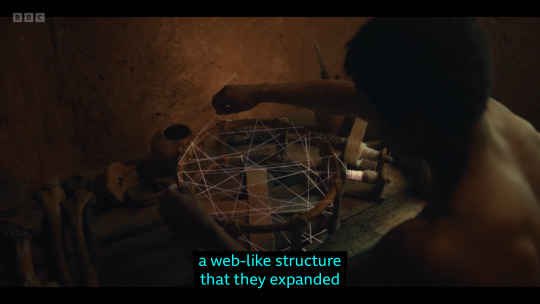
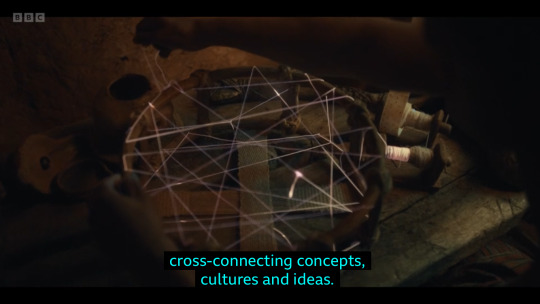


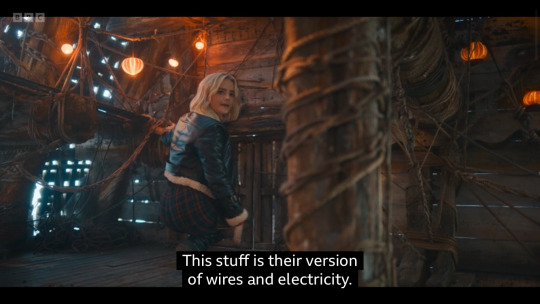

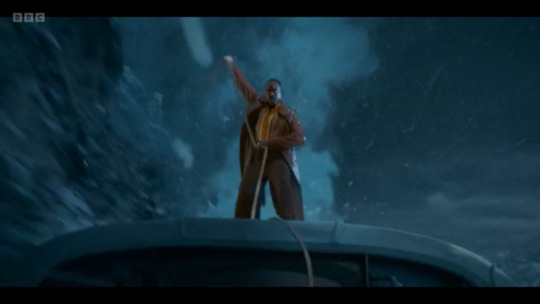

it’s Anansi’s spider-web, it’s the network of stories, it’s the invisible threads of TV broadcasting and the internet and patterns and hyperlinks connecting one fate to another, it’s Belinda and Mundy, it’s the red string on corkboard of a post-truth conspiracy theorist like Conrad, it’s lies-that-become-reality, it’s fairy circle string and celluloid film tape and a rope to stop a train and the Story Nexus and the Web of Time; and i’m not sure what it’s all leading up to, but there must be something to it
this may all sound like a bit of a reach to you. like i’m tracing a motif that’s not really there. engaging in wishful thinking (as if i live on Wish World, coming up in two weeks! interesting episode title, that.) but i’m not the only one — jamie cowan, DWEU author and one of the people who genuinely knows more about this show than the rest of the planet, agrees with me. and if you needed further confirmation…
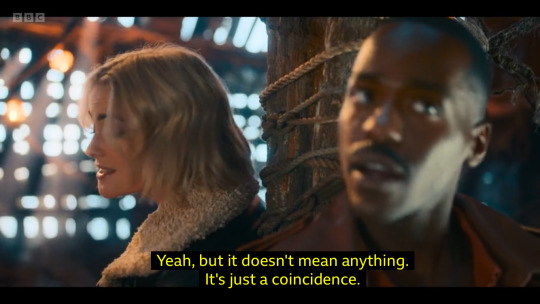
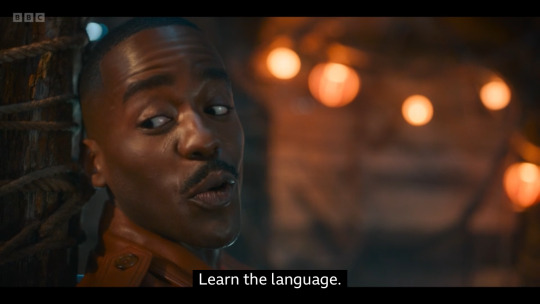
#there are no coincidences in rtd2. only synchronicities#but fyi i use the tag for just about any metaposting re: 15’s era right now#the language of rope#doctor who meta#dw#doctor who#doctor who theory#doctor who analysis#doctor who series 15#doctor who series 14#russell t davies#steven moffat#inua ellams#73 yards#the church on ruby road#the story and the engine#joy to the world#doctor who lux#belinda chandra#ruby sunday#fifteenth doctor#fifteen#ncuti gatwa#anansi#doctor who season 1#doctor who season 2
406 notes
·
View notes
Text
@ ALL RISE FANS THAT MAKE COMICS & STORIES
So I’ve noticed that in this fandom it’s common to include Deaf/ASL-using-characters into stories, which is honestly AMAZING and makes me SO HAPPY TO SEE, but many of us aren’t deaf we rely on resources, therefore:
My ASL teacher gave us this website cause it’s updates constantly (ASL evolves lots) and it’s a lot more accurate and reliable than just google :))
To work it- type the word, and a word bank will pull up, click on the term u want and a video/description of the sign and word will appear!!!
It’s rlly simple and has most words and if it doesn’t it’s bc it’s finger spelled probs!!!!
If u want more in-depth good grammar, search up “five parameters ASL”, “glossing in ASL” and watch a few videos to see “how sentence structure differs in ASL”
As always, remember it’s ok to make mistakes/notice a mistake, just be mindful and kind :D most of us aren’t out for malice and if someone is it’ll probs be very obv 😭
Happy Creating!!
Edit: A THANK U SO MUCH FOR THE REBLOGS :)) if anyone ever needs any help drop a comment or look at other reblogs!! There’s lot of other resources/tips there!!!
#tmnt#rottmnt#rottmnt fanart#save rottmnt#rottmnt donnie#rottmnt fanfic#rottmnt writing#rottmnt fandom#rottmnt analysis#asl#sign language#deaf community#rottmnt fanfiction#rottmnt fanfic recs#tmnt fanfiction#tmnt fanfic recs
6K notes
·
View notes
Text
Shape Language in Cinderella Boy: An Analysis
Hello, world, I come with an analysis. Also known as more proof that Punko is a genius, in case you were in doubt.
So first of all, we know that violet is a beautiful iconic queen.

Look at her. Queen.
Violet's features are very distinctive - all of the keys are very distinctive. She has tall shoulder pads that slim down to a form-fitting dress that wraps around her ankles - in this way, she is shaped more or less like an arrow, pointing downwards.

Now let's look at Buddy's outfits throughout season one.

Violet gives him this same shape, time and time again. He is shaped like Violet is, through the clothes that he wears; this downward arrow sort of look. And it fits both of them; villans are commonly pointy. If you look at many villanous characters in media, you will see that triangles are incorporated into their designs all the time. Triangles are less friendly looking than other shapes - they make us think of sharp, pointy things. And Buddy's outfit contributes to it, too. The way his shoulder pads, fabric layers, and even boob windows are shaped all contributed to this sort of top-heavy, narrowing atmosphere. (It also makes him look pretty, which he is).
Now let's look at Silver.

Silver is less pointy than Violet because her job is the heroine, and when we see round things, we think of them as more comfortable objects - soft, smooth, not prickly to the touch. Friendly. But in addition to this roundness, Silver is shaped like an hourglass, a shape feminine and strong. And if you look at the outfits worn by Chase:

They often don this same hourglass shape. Interesting too because usallly the hourglass is more prominent on the bottom (most obvious in the 2nd image above), which means that if you simplify him, he is often shaped as a triangle with the base resting on the ground - while Buddy is an upside down triangle. They are each other's opposites, not only in archetype and personality, but in their simplest composites: their actual physical shape.
It works for Deacon and Bronze, and Prunella and Goldie, too. The outfits of the keyholders match the shapes of the keys.

Bronze is shaped like a rectangle...

Deacon is a gawky boy.

Square shapes are often sturdy and reliable. As the helper, this is Deacon and Bronze's whole job. In addition, you can see that sometimes Deacon also dons a trapezoid shape around his shoulders, with the shorter base on the top and the longer base on the bottom. This is most noticable with the Still Waters and RoBaM arc outfits, and it also contributes to this feel of "groundedness".
Finally, Goldie and Prunella. I think this is the most clear example.

Goldie is not pointy. He is round, friendly, and affable. His smile is rounded, his eyes are round, even the tips of his hair do not sharpen to a point. He has the same roundness that Silver does, particularly in his shoulders (REMEMBER THIS, THIS WILL BE IMPORTANT LATER), and his armor gives him another larger circle to more or less center the two smaller circles. Thus, Goldie is shaped like Mickey Mouse.

And it is very. Very. Very obvious with Prunella.
Because she is a kid. She's innocent, childish, carefree - I wouldn't say playful, nessecarily, but her age alone implies that she is much more of this rounded shape than the older characters.
And these clothes support their personalities. Like a bow or an hourglass-shaped dress, Chase is feminine and cute; Deacon is sensible and grounded, reliable. Buddy is all triangles, he's prickly and triangles also have a proven visual appeal to them that Buddy is well able to match. And Prunella has shapes of circles and hearts and semicircles in her outfits - what I like most about her shape language is that even though I illustrated her skirt as a circle, it is often flat on the bottom, which ALSO makes her seem grounded, just like Deacon's trapezoid.
Buddy's shoulder pads intriuge me most. Because they are all very pointy. Look at his cat outfit, or those over-the-top shoulder pads in Sick Day. All except for one arc.
Still Waters.
The finale.
Because of the way Buddy's outfit is, he still has the arrow shape that Violet does. However, this time, due to the fluff, his shoulders are much more rounded.
Like Silver.
Like Goldie.
Like a hero.
Like, Y'ALL.
ROUND:

POINTY:

ROUND.
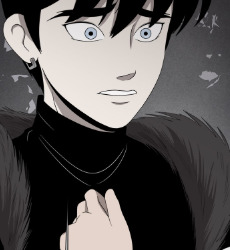
Because this arc, this moment, is when Buddy becomes a hero. He stops with the triangle-shaped shoulder pads that have until now been cohesive with villainry, and donned the roundness to his shoulders that the hero archetypes have, via the fluff.
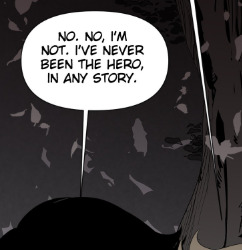
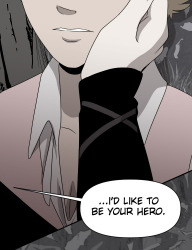
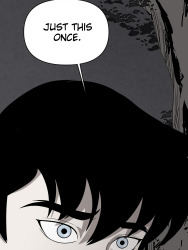
And it's really, really cool.
And what's also cool about it is that it doesn't only extend to these outfits!! Compare Deacon and Chase's houses, for example; there is shape language there. It's everywhere in a lot of media, and it is so cool to me that it was intergrated into Cinderella Boy in this way.
Sadly I already typed this out once before, accidentally deleted it, and had to rewrite it - so I'm going to stop there, lol. I promise the analysis of the Still Waters fit was much more cohesive the first time, but I think the point still gets across
I did it. Tada
#cinderella boy#cinderella boy webtoon#cinderellaboy#buddy cinderella boy#punko#cb analysis#shape language#woo
341 notes
·
View notes
Text

Dustin's hesitancy and their concern over him. He's deep in the throes of grief.



They don't know if he's gonna say yes.
He's been withdrawn, I can feel it.
He's the last one to put his hand on and there's a close shot of it for a reason. Because they all put their hands in the middle immediately and he couldn't at first.
It reminds me of Max last season. Withdrawn, friends unsure of his participation, closed off but ultimately just in need of support and a well-needed cry, but he has to move through his arc to get to the point where he can let himself go like that.

#the party#stranger things 5#st predictions#stranger things#dustin henderson#body language#dustin henderson analysis#dustin henderson arc
242 notes
·
View notes